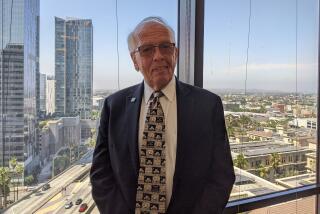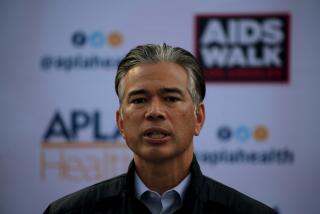Ousted Founder Doesn’t Mourn End of FHP Name
- Share via
FOUNTAIN VALLEY — PacifiCare Health Systems Inc.’s pending acquisition of FHP International Corp. signals the end of a health-care experiment launched 35 years ago by an ambitious Long Beach doctor.
Bored with treating patients and searching for a more rational health-care payment system, Dr. Robert Gumbiner started FHP in the early 1960s. Over the next 30 years, he built the company into an HMO giant.
But today Gumbiner is more complimentary of PacifiCare than of FHP, an indication of the bitterness he harbors against his former company and the direction it has taken since he was bumped from its executive ranks last year.
In fact, in an interview Monday, the 73-year-old Gumbiner said he is not even saddened that the FHP name--originally standing for Family Health Program--may soon disappear from the health-care landscape.
“I’m more concerned about the whole concept of it disappearing,” he said. The executives who have led FHP in recent years, he said, “changed the culture from growth and innovation into one that fundamentally was geared to improve shareholder value.”
Gumbiner’s successors at FHP say they honor his contributions to the company and the health-care industry, and share his commitment to quality care. But they and numerous industry analysts point out that many of Gumbiner’s ideas--including his belief that health-care companies should own their own hospitals and employ their own doctors--have simply become outdated in an increasingly competitive industry.
Back when Gumbiner was just starting the company, those ideas were fairly radical.
Kaiser Permanente of Oakland is generally credited with pioneering the HMO model, a health-care system that seeks to reduce costs by controlling patients’ access to care. Gumbiner started out hoping, as he says, “to provide a program that was better than their plan, more innovative in responding to patients’ needs.”
Gumbiner began in 1961 by converting his group medical practice to a nonprofit corporation serving about 2,000 patients. By the end of the decade, the company that became FHP had more than 10,000 patients with medical centers in Long Beach and Fountain Valley.
As it continued to grow, FHP always reflected the ideas and interests of its founder. The company expanded into Utah, where Gumbiner liked to ski, and Guam, where he went scuba-diving. By the late 1970s, FHP had 11 medical centers, including a 22,000-square-foot facility in Anaheim.
Along the way, Gumbiner steered FHP in new directions that many companies in the industry still follow today. In the early 1980s, for instance, FHP developed a prepaid health-care program for Medicare recipients.
The company provided the federal government “with all the basic benefits of Medicare for 95% of what the government was paying other providers,” Gumbiner said. “There was so much waste that I was able to provide all the benefits, remove the 20% co-payments and add prescription drugs and preventive care.”
And still make a profit, he might have added.
Gumbiner said competitors scoffed at the plan then, but copy it now. “PacifiCare pretty much imitated the program I set up,” Gumbiner said, perhaps explaining why he is quite complimentary toward PacifiCare.
“I think PacifiCare is probably one of the best operations out there,” he said.
FHP converted from a nonprofit to a for-profit corporation in 1986, and over the next decade grew to a giant plan with annual sales of $3.9 billion and 1.9 million members.
Gumbiner stepped down as chief executive in 1990 to make way for Westcott W. Price III. The founder kept his position as chairman of the company, but that would change following FHP’s $1.1-billion acquisition of TakeCare Inc. in 1994.
Buying TakeCare, an HMO with operations in four states including California, dramatically raised the company’s market share, but led to a series of management scuffles that some say weakened FHP and made it vulnerable to acquisition.
Gumbiner was bumped from his position as chairman during a boardroom coup that took place while he was still weak after surgery for prostate cancer. Taking his place was Jack R. Anderson, formerly chairman of TakeCare Inc.
Shortly thereafter, the company announced a major change in direction: It would sell two hospitals, lay off hundreds of employees and move its 500 doctors into a new company that would serve patients outside FHP’s membership ranks. Gumbiner opposed all those moves then, and still does.
In particular, Gumbiner still insists that today’s health-care companies need to own their facilities because the aging baby boomers are going to stretch the system’s capacity and raise costs as they move into retirement. Owning facilities is the only way to control those looming costs, he says.
Alan Hoops, chief executive of PacifiCare, said Gumbiner could turn out to be right, but added: “I’m not as certain of what the future will hold as Mr. Gumbiner is.”
Gumbiner offered few thoughts on the acquisition of his former company, other than to say he believes FHP’s executives “have lined their pockets pretty well.”
But Gumbiner’s pockets aren’t without lining either. He still lives in Long Beach today, and is one of the city’s most prominent residents. Several years ago, he even contributed millions of dollars to efforts to restore the Queen Mary.
In fact, Gumbiner still owns about 125,000 shares of FHP, shares that rose in value more than $900,000 Monday after the PacifiCare acquisition was announced.
More to Read
Inside the business of entertainment
The Wide Shot brings you news, analysis and insights on everything from streaming wars to production — and what it all means for the future.
You may occasionally receive promotional content from the Los Angeles Times.










